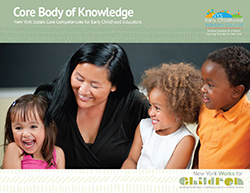
Core Body of Knowledge
New York State's Core Competencies for Early Childhood Educators

5.6
Resources for Competency 5.6:
click to view resource list
Ensure Safe Learning Environment
The professional working with young children takes appropriate precautions and follows applicable procedures to ensure a safe learning environment
Resources & Media for Understanding Competency 5.6
Behaviors & Skills
-
aMakes sure the physical environment (space, materials and equipment) is safe and is checked on a regular basis and follows all safety regulations as outlined by applicable regulatory agencies or programs
-
bKeeps pathways and play areas clear and free from tripping hazards
-
cPositions oneself to see all children. Counts heads throughout the day and frequently scans the room to make sure all children are present and safe
-
dSupervises infants and toddlers at all times by sight and sound
-
eClosely monitors transitions between the classroom and other areas (i.e., the playground) and checks frequently on children who are out of sight (i.e., in the bathroom, visiting the nurse's office, etc.)
-
fEnsures safe sleeping:
- Checks the sides of cribs to be sure they are locked
- When children are sleeping, uses direct visual and auditory monitoring, rather than relying on sound monitors
- If working with infants, makes sure that they are placed to sleep on their backs, on a firm surface made for infant sleep that meets U.S. Consumer Product Safety Commission
- If working with infants younger than eight months of age, makes sure that cribs are free of loose blankets, stuffed toys, pillows and other objects
- Takes all other precautions outlined by applicable New York State or New York City regulations to reduce the risk of Sudden Infant Death Syndrome
-
gProtects children from getting burned by hot liquids, foods, or tools (i.e., hot plate, oven, boiling water, etc.)
-
hUses child-appropriate methods like dramatics and story-telling to teach children:
• What to do in an emergency and where to get help
• Pedestrian safety rules
• Fire safety
• Basic water safety rules
• Stranger safety
• Poison prevention
-
iWhen age-appropriate, involves children in creating and enforcing safety rules. Checks to makes sure children understand the rules and expectations
-
jPays extra attention to safety during field trips and neighborhood excursions
-
kFollows procedures for safe dropping off and picking up of children from the program
-
lWhen working in the child's home, helps families to monitor their environments for safety risks
